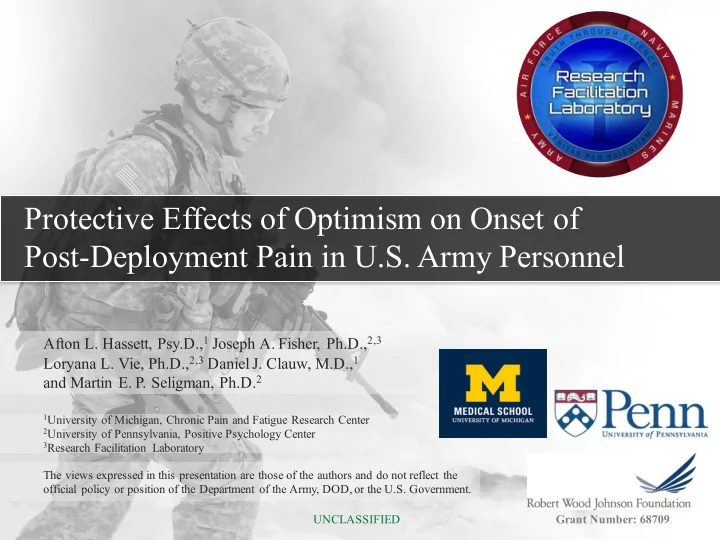

Protective Effects of Optimism on Onset of Post-Deployment Pain in U.S. Army Personnel Afton L. Hassett, Psy.D., 1 Joseph A. Fisher, Ph.D., 2,3 Loryana L. Vie, Ph.D., 2,3 Daniel J. Clauw, M.D., 1 and Martin E. P. Seligman, Ph.D. 2 1 University of Michigan, Chronic Pain and Fatigue Research Center 2 University of Pennsylvania, Positive Psychology Center 3 Research Facilitation Laboratory The views expressed in this presentation are those of the authors and do not reflect the official policy or position of the Department of the Army, DOD, or the U.S. Government. UNCLASSIFIED Grant Number: 68709
Chronic post-deployment pain is common - observed in 40-80% of veterans deployed to Afghanistan or Iraq. 1-4 Veterans are 40% more likely to experience pain. 5 • Up to 51.2% report pain severity to be moderate to severe. 3 • Over half experience pain almost every day, if not constantly. 3 • 29% have reported pain in all four limbs (widespread pain). 6 • 1) Cifu et al. J Rehabil Res Dev. 2013;50:1169-76. 2) Lew et al. J Rehabil Res Dev. 2013;50:xi-xiv. 3) Toblin et al. JAMA Intern Med. 2014;174:1400-01. 4) Gironda et al. Pain Med. 2006;7:339-343. 5) Nahin. J. Pain 2017;18:247-54. 6) Helmer et al. Pain Med 2009;10:11724-82. 2 UNCLASSIFIED
Chronic pain in veterans is associated with significant psychological, social and behavioral problems. l Comorbid PTSD, depression and/or substance abuse. 1-6 l Traumatic brain injury/post-concussive symptoms. 1,2 l Greater healthcare utilization. 4-5 l Diminished quality of life or well-being. 5 1) Cifu et al. J Rehabil Res Dev. 2013;50:1169-76. 2) Lew et al. J Rehabil Res Dev. 2013;50:xi-xiv. 3) Toblin et al. JAMA Intern Med. 2014;174:1400-01. 4) Lang et al., Mil Med 2016;181:50-5. 5) Helmer et al. Pain Med 2009;10:11724-82. 6) Forman-Hoffman et al. J Pain 2007;8:954-961. 3 UNCLASSIFIED
Risk factors for post-deployment pain have been studied, but little is know about protective factors. l Demographic factors: greater age, being married. 1 l Combat factors: injury during combat, combat intensity. 1-2 l Psychological distress: especially PTSD. 1,3 1) Toblin et al. JAMA Intern Med. 2014;174:1400-01. 2) Cifu et al. J Rehabil Res Dev. 2013;50:1169-76. 3) Stratton et al. J Pain 2014;15: 1023-1032. 4 UNCLASSIFIED
Study Purpose: To assess protective factors for the development of new post-deployment pain. Study Design Pre-deployment Deployment Post-deployment assessments of health health assessment and well being • New pain • Iraq or • Pain free (head, joint, back) Afghanistan (head, joint, back) • Combat stress • Optimism • Injury 5 UNCLASSIFIED
Data Requirements • Pre-Deployment: Periodic Health Assessment – most recent within 12 months of deployment − Global Assessment Tool – most recent within 12 months of deployment − • Deployment: Contingency Tracking System –Army Active/Guard/Reserve deployment (0 to 18 − months) between 2010 and 2014 that included time in Afghanistan or Iraq • Post-Deployment: Periodic Health Assessment – Most recent within 15 months following deployment − return Post-Deployment Health Assessment – Most recent within 6 months following − deployment return • Additional model and data availability constraints. n = 21,390 soldiers 6 UNCLASSIFIED
Sample Characteristics Sample No New Pain New Pain N = 21,390 n = 13,413 (62.7%) n = 7,977 (37.3%) Sex: Male = 87.9% Male = 88.1% Male = 87.4% Age: Mean (SD) 29.3 (8.5) 28.5 (8.1) 30.5 (8.9) Branch: Regular = 36.7%, Regular = 36.4%, Regular = 37.3%, Guard = 42.3%, Guard = 41.7%, Guard = 43.2%, Reserve = 21.0% Reserve = 21.9% Reserve = 19.5% Location: Afghanistan = 77.4%, Afghanistan = 75.9%, Afghanistan = 79.9%, Iraq = 22.6% Iraq = 24.1% Iraq = 20.1% Education: < HS = 9.1%, < HS = 8.9%, < HS = 9.4%, HS = 58.1%, HS = 58.7%, HS = 57.0%, > HS = 13.7%, > HS = 13.2%, > HS = 14.6%, ≥ Bachelor = 19.1% ≥ Bachelor = 19.2% ≥ Bachelor = 19.0% Optimism: Mean (SD) 3.9 (0.75) 3.9 (0.74) 3.8 (0.77) 7 UNCLASSIFIED
Logistic Regression Results: Predicting New Pain Model 1 – Model 2 – Optimism Continuous Optimism Tertiles a OR (95% CI) Optimism 0.89 (0.86, 0.93) *** Mod.: 0.81 (0.68, 0.96)* High: 0.70 (0.59, 0.83)*** Age 1.40 (1.35, 1.45)*** 1.40 (1.35, 1.45)*** Gender - Female 1.22 (1.12, 1.34)*** 1.22 (1.12, 1.34)*** Education - ≥ Bachelor 0.80 (0.71, 0.91)*** 0.80 (0.71, 0.91)*** Branch - Guard 0.90 (0.84, 0.96)** 0.90 (0.84, 0.96)** Reserve 0.74 (0.68, 0.80)*** 0.74 (0.68, 0.80)*** Location - Iraq 0.81 (076, 0.87)*** 0.81 (0.76, 0.87)*** Nicotine 1.15 (1.08, 1.23)*** 1.15 (1.08, 1.23)*** Skin (hives/rash) 1.40 (1.16, 1.69)*** 1.40 (1.16, 1.69)*** Chronic pain 2.55 (1.80, 3.61)*** 2.55 (1.80, 3.62)*** Combat stress 1.13 (1.11, 1.16)*** 1.13 (1.11, 1.16)*** Injury 2.18 (2.03, 2.33)*** 2.17 (2.03, 2.33)*** Note . Mod. = Moderate. a Reference group = Low optimism. Non-significant model variables: income, alcohol use, blood pressure, number of prior deployments, and education (at levels HS, >HS) Sample size = 21,390 soldiers. * p < 0.05, ** p < 0.01, *** p < 0.001. 8 UNCLASSIFIED
Study Conclusions l Mean optimism was associated with a 11% reduced odds of developing new post-deployment pain. l High vs. low levels of optimism were associated with a 30% reduced odds of developing new post-deployment pain. l Reducing instances of new pain post-deployment is critical as 37% of soldiers report at least one new area of pain. l The results of this study suggest that future research targeting increasing levels of optimism could be warranted. 9 UNCLASSIFIED
Thank you! • Thank you to all who have served and continue to serve our country and protect us from harm. UNCLASSIFIED
Recommend
More recommend